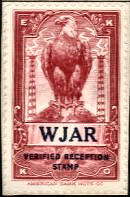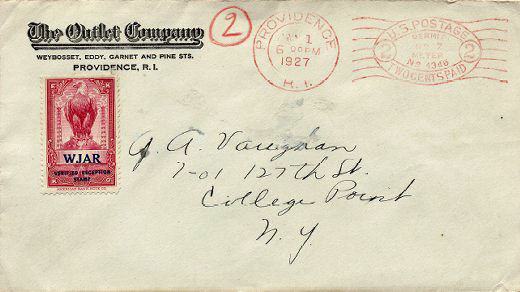![]()
Postal History Introduction
Stampless
Covers
1846
to 1900 Issues
1901-1950
Issues
1951-2003
Issues
Cancels
&
Miscellaneous
Postal
Stationery
Post
Cards
Air
Mail
First
Day &
Event Covers
Parcel Post/Special Delivery
Registered & Official Mail
Commercial & Advertising
Revenue & Postage Due
Wildlife & Game Issues
Complete List of RI Issues
|
Rhode Island Stamps
and Covers - Cinderella Issues |
|
WJAR
AM Radio was launched on August
2, 1922 by The Outlet
Company, (department store) at 5000
watts on Channel 920,
(kilohertz). The department store entered the radio broadcasting
field to increase the sale of their records. During the 1970's WJAR
was the flagship
station of the Outlet Broadcasting Company. After World War II, The Outlet Company added WJAR-TV, initially operating from its downtown store building and later from a new facility on Dorrance Street. The radio station was spun off from the TV Station in the late 1970's and became WHJJ AM Radio. |
|
|
The EKKO Company of Chicago, Illinois came up with the idea of having broadcast radio stations provide Verified Reception Stamps to their listeners. EKKO provided an album for $1.75, which contained outlines of each of the stamps/stations currently available. The album contained a map showing the locations of the stations with blank spaces for additional new stations. There was also space provided to write down the dial settings at the time of reception. Proof of Reception Cards were provided with the album. Listeners would search the dial for distant signals waiting for the call letters. They would then look up the station address in the EKKO directory and fill out the card with the time and dial settings of the station heard and send it along with 10 cents to the station. The station would verify the card against their logs for accuracy and send the listener an EKKO stamp with the station's call sign on it. They frequently would also include letters and or station cards and other material with the stamp. I received the stamp shown above unused and not attached to a cover or card. EKKO collectors prefer them attached and they bring much higher prices when affixed to the original cover or card from the radio station. The stamps were produced by the American Banknote Company. A good friend of mine and fellow stamp collector and dealer, Joe Colello owns one of the finest collection of EKKO stamps and covers in the country - (originally the G. A. Vaughn Collection). He recently sent me a CD disk with an absolutely fascinating Adobe Reader slide show depicting the collection. Vaughn logged and recorded remote radio stations on a two-tube radio from 1925 to 1938, collecting over 1000 verified reception reports from 15 different countries in various mailing formats including postcards, postal cards and letters. Joe has given permission to use one of these for this presentation and I found a WJAR Providence on Cover while browsing the disk which is shown below. |
||
|
||
The Outlet Company The Manufacturers Outlet Company was started in 1894 as a discount menswear store by Joseph and Leon Samuels on Weybosset Street in Providence, Rhode Island. The company grew quickly, and expanded into a full department store with the construction of a new addition in 1903. The company began operating their own radio station, WJAR in 1922 and added a television station in 1949. The company acquired additional stores across the country and eventually owned 91 retail stores. They also continued to acquire additional radio and television stations. In 1980, the company sold their retail business to United Department Stores keeping only their broadcast business. They merged with the Rockefeller Group in 1984 as Outlet Communications and continued to operate WJAR TV until 1996, when it was sold to NBC. NOTES: 1) AM, (Amplitude
Modulation) is a method used to modulate a radio signal.
The amplitude of the radio wave is modulated to be directly proportional
to the value of the analog signal at the time. Early radio stations all
operated in the AM Band,
(typically 640 to 1600 KHz). |
||
![]()
RI Historical
Society
The Post Offices
Home Page
RI Tercentenary Issue History
RI Philatelic Society
Recently Added Pages
Philatelic Primer
Rhode Island Around the World
Rhode Island
Town Postmarks
Other Websites of Interest

